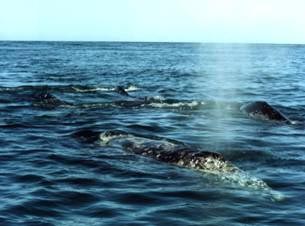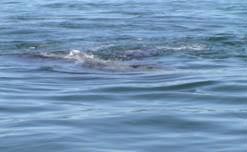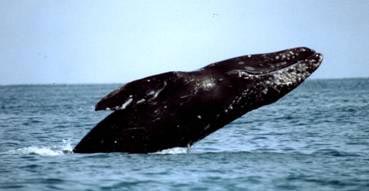Grey Whale
Classification
- Common name: Ballena Gris, (Gray Whale)
- Scientist name: Eschrichtius robustus
- Order: Cetaceos
- Suborder: Mysticeti
- Family: Eschrichtidae
- Subfamily: Agaphelinae
- Gender: Eschrichtius
- Born Size: +/- 4.5 m . ( 16 ft .)
- Maturity Size: +/- 15m. females and 12m. mates
- Born Weight: 1 ton.
- Maturity Weight: 35-45 tons.
- Color: Black, the gray tone it is caused by barnacles growing in the skin or by depigmented areas where barnacles have been.
- Maturity: The sexual maturity is acquired between the 6 and 8 years old; the physic maturity comes around the 30 years.
The Grey Whale
The gray whale is the most common large whale seen from shore along the west coast of North America . Gray whales are found off the Oregon coast all year. They feed in shallow water near shore during the summer and fall, migrate south for breeding and calving during the winter, and migrate north in the spring.
Description
The gray whale gets its name from its blotchy color pattern. Some of this pattern is present at birth, but most of it is caused by barnacles growing in the skin or by depigmented areas where barnacles have been.
Gray whales reach 45 feet ( 14 meters ) in length and weigh 35 tons (31.5 metric tons). For comparison, a cross-country bus is 40 feet ( 12 meters ) long. Adult females on average are larger than males. Whales are mammals. They are warm blooded, breathe air, have hair (single hairs around the front of the head that are visible on calves), and give birth to live young that suckle on milk from their mothers.
Feeding
Midspring to midfall is the gray whales' feeding season. Most of the population spends this time in the Bering and Chukchi Seas off Alaska , although every summer some whales are observed feeding from British Columbia to Mexico . The summer population off the Oregon coast often numbers 200 to 400 animals, with many of the same individuals returning year after year. Summer feeding is better at higher latitudes because the long days produce lots of phytoplankton (small marine plants), which are eaten by zooplankton (small marine animals). Together, these are the basic food for all ocean life, stimulating the growth of the marine food web, including bottom-dwelling amphipods, the primary prey of gray whales.
There are two basic types of whales: toothed and baleen. The gray whale is a baleen whale. Instead of true teeth, a row of 138–180 baleen plates grows along each side of the upper gum line. The baleen is made of material like a human fingernail.
Appearing quite stiff and solid at its outer edge, each piece of baleen is “fringed” inside the mouth and tapers from 3 inches wide at the gum line to nearly a point at its bottom. These plates are separated by approximately 1.3 inch (6 to 10 mm ) inside the mouth, where their fringes overlap to form an effective screen.
Gray whales feed primarily on benthic (bottom-dwelling) amphipods (shrimplike animals). They go to the seafloor and suck up an area of the bottom about the size of a desktop and a foot deep. Sometimes this makes conspicuous pits on the bottom. The amphipods are trapped on the baleen filter inside the mouth, while mud, sand, and water pass between the baleen plates. This is the way the whale washes the amphipods clear of sand and mud. It then uses its tongue to suck the amphipods off the inside of the baleen fringe, much the way you might suck peanut butter off the roof of your mouth. Since gray whales filter animals from mud and water, their baleen is stiffer and has coarser fringes than that of other baleen whales, which filter animals from water only. Sometimes you can see muddy water near the gray whale's head when it surfaces from a feeding dive.
From time to time, gray whales feed along rocky headlands on swarming mycids, swimming shrimplike animals about 3.4 inch long. Sometimes their feeding takes them into very shallow water just outside breaking waves along shallow, sloping, sandy beaches. This often results in false stranding calls from people who assume the animals are in trouble. In fact, they are feeding in the furrows you sometimes can see in these areas during low tide.
Reproduction
When the whales arrive in Mexico , births take place in lagoons as well as offshore. Births begin around Christmas and peak in early February. Females give birth to a single calf once every two years after they become sexually mature (at about eight years old). They mate in years when they are not bearing a calf. Going south into temperate or subtropical waters to calve is typical of most baleen whales and presumably helps the newborn whales conserve body heat. Whales may favor lagoons because they are protected areas of calm, warm water. Mexican fishers also report that there are very few sharks in the lagoons when the whales are present.
The 15-foot ( 4.5 meter ) calf is born tail first and weighs approximately 1 ton (0.9 metric ton). The calf's breathing is awkward at birth, but within several hours the animal is making smooth dives. It breathes about twice as frequently as its mother for the first several weeks.
The male takes none of the responsibility for newborns. Calves nurse from their mothers for approximately six to eight months, acquiring more independence during the last third of the suckling period. Females have two teats, one on either side of the genital slit. Their milk is 50 percent fat. This conserves water for the mother and makes the milk a compact “glob” that sticks to the calves' baleen.
Migration towards the south
After feeding during the summer and fall, the entire gray whale population heads south. Early December is the beginning of the southward migration in the Pacific Northwest . Along the Oregon coast, the migration usually reaches a peak during the first week of January at a rate of 30 animals per hour. By mid-February, most of the whales have left Oregon waters. Pregnant females are the first to migrate, followed by mature adults of both sexes and then by juveniles. Whales travel at a rate of up to five miles per hour during the southbound migration. It takes them about three weeks to get to Mexico . Examinations of the stomachs of whales during the whaling days indicated that gray whales eat very little while migrating and while in calving areas. Thus, many whales may go without food for three to five months.
The animals travel south to the three major breeding and calving lagoons on the west coast of Baja California, Mexico: Laguna Ojo de Libre, adjacent to Laguna San Ignacio; Guerrero Negro Lagoon (also known as Scammon's Lagoon); and Magdalena Bay. Captain Charles Scammon charted many of these areas in the mid-1800s as he hunted gray whales. His book, Marine Mammals of the Northwest Coast , has been reprinted in paperback and makes interesting reading.
Migration towards the north
By March, whales already are returning northward along the Oregon coast. The northbound migration begins with immature animals (some of which may not have gone all the way to Mexico ), adult males, and females without calves. These animals pass the Oregon coast from early March through April. Breeding sometimes is observed at this time.
Calves usually are rambunctious but stay close to their mothers as they become more coordinated and develop an insulating blubber layer. Calves are at least a month old before they migrate north with their mothers. Mothers and calves are the last to leave the lagoons and move somewhat more slowly, passing Oregon and Washington from late April through June.
During the spring migration, if the weather is good, you can see whales within a few hundred yards of coastal headlands.
The full round-trip migration from the Baja calving lagoons to the Bering Sea and back is 10,000 miles ( 16,000 km ), the longest known for any mammal. Other whales also are known to migrate between summer high-latitude feeding grounds and more temperate lowlatitude breeding and calving areas. However, researchers know more about the gray whale because it moves so close to shore. This nearshore movement has led to speculation that gray whales navigate by staying in shallow water or keeping the surf noises to one side or the other, depending upon their direction of travel.
Operation and conservation
The regularity of the gray whales' movements made it possible for whalers to exploit them heavily along the migration route and in the calving lagoons. Around 1855, shore processing stations were set up in San Diego. At that time, navigation inside the bay was judged hazardous because of the abundance of breeding whales. By 1873, gray whales had been so reduced in number that these shore stations closed. Whaling continued within the Mexican lagoons, and the gray whale population was further depleted until the lagoons were closed to whaling by the Mexican government in the early 1900s. Full protection was extended to gray whales in 1937 by the League of Nations , and in 1946 by the International Whaling Commission.
After 57 years of protection from commercial hunting, the gray whale population had recovered sufficiently to be removed from the Endangered Species List in 1994. At that time, the population was estimated at 23,000, which is thought to be close to the prewhaling population. A quota of 176 whales a year is harvested along the Siberian coast. That number was determined by the average number that had been taken throughout the last 20 years of the recovery period, during which the population continued to grow.
Gray whales are protected under the Marine Mammal Protection Act by National Marine Fisheries Service guidelines that require boaters not to approach within 100 yards of the animals. Inappropriate tourism can be a harassment that affects the animal's use of important habitats. Industrial development in some of the breeding, calving, and migration areas may be the greatest threat to the gray whales' future.
The only natural predators of gray whales are killer whales and large sharks. Killer whales tend to show up along the Oregon coast during late April and May and may target females and calves migrating north.
Bruce R. Mate, Extension Sea Grant marine biologist, Oregon State University.
Ilustrations by Pieter Arend Folkens.
How to make a good observation of Grey Whale?
Mamíferos de sangre cálida y respiradores que amamantan a sus crías a pesar de pasar todo el tiempo en el agua, la ballena grís tiene su comportamiento bien definido; es además el mamífero que realiza la mayor migración en el reino animal recorriendo al año alrededor de 20,000 km. desde las frías aguas del ártico, a las cálidas lagunas y costas de Baja California Sur, México. Estos son algunos aspectos que se deben buscar en un avistamiento de ballena grís.
 ©Luis Enrique Achoy Cota |
Rhythmic Breathing Patterns: Help in Predicting when Whale will Surface – Normally Gray Whales will make three to five short , shallow dives, of less than a minute each, and then long deep dive. This repeated breathing pattern enables the Whale to store up oxygen and get rid of carbon dioxide built up during the long dive. A general rule is one short dive and blow for every minute spent in a deep dive. |
 ©Luis Enrique Achoy Cota |
Showing of tail flukes signals deep dive: After making a series of short surface dives, the whale makes a deep dive lasting for three to five minutes. Dipping its head and lifting the flukes entirely out of the water, its uses the thrust and weight of its tail to plunged downward. |
 ©Luis Enrique Achoy Cota |
“ Footprints “ Mark Whales Movements: When a Whale is swimming just below the surface, the powerful up and down movement of its tail boily the water and leaves a tell-tale “footprint” on the surface. This disturbance looks like an oil slick, and in calm water marks a clear path to follow. |
 ©Luis Enrique Achoy Cota |
Spyhopping: poking their heads up out of the water and hovering there with the eye exposed is a behavior frequently seen. It is believed that the whale is visually orienting it self or just looking around above the surface. |
 ©Luis Enrique Achoy Cota |
Breaching: a Breach is a spectacular sight you won't soon forget. The whale rises up to ¾ of it body out of the water, turns sideways and then falls slowly backward landing in an explosion of flying water. They may do this to knock loose parasites, may be a courtship display or they are just having fun. |
